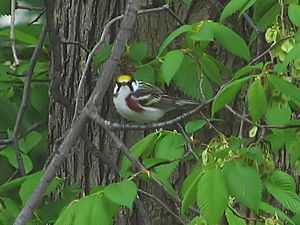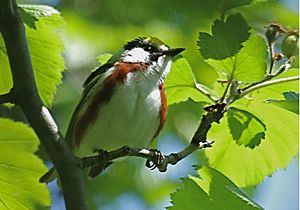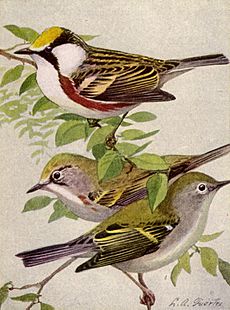Chestnut-sided warbler facts for kids
Quick facts for kids Chestnut-sided warbler |
|
|---|---|
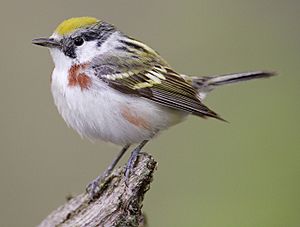 |
|
| Adult in summer plumage | |
| Conservation status | |
| Scientific classification | |
| Genus: |
Setophaga
|
| Species: |
pensylvanica
|
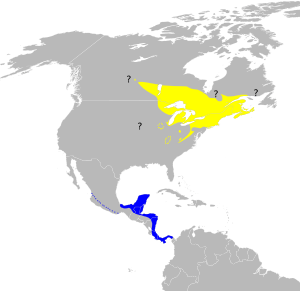 |
|
| Breeding range Wintering range | |
| Synonyms | |
|
|
The chestnut-sided warbler (Setophaga pensylvanica) is a small, colorful New World warbler. These birds spend their summers breeding in eastern North America. You can find them in southern Canada, stretching west to the Canadian Prairies. They also live around the Great Lakes and in the eastern United States.
Contents
What's in a Name?
The scientific name for the chestnut-sided warbler is Setophaga pensylvanica. The first part, Setophaga, comes from Ancient Greece. It means "moth-eating." The second part, pensylvanica, means "from Pennsylvania." This tells us where the bird was first described.
Where Do They Go?
These birds are migratory. This means they travel long distances each year. They spend their winters in Central America, going as far south as northern Colombia. Sometimes, they are even seen in Ecuador. They are also very rare vagrants (birds that wander far from their usual areas) in western Europe.
Chestnut-sided warblers usually arrive in their breeding areas in May. They leave by mid-September to fly south for the winter.
What Do They Look Like?
The chestnut-sided warbler is a medium-sized New World warbler. It is about 10 to 14 cm (3.9 to 5.5 in) long. Its wingspan is about 16 to 21 cm (6.3 to 8.3 in). These birds weigh between 8 to 13.1 g (0.28 to 0.46 oz).
In summer, male chestnut-sided warblers are easy to spot. They have dark streaks on their gray backs. Their faces are white, with a black stripe through their eyes. They also have a greenish crown on their heads. Their bellies are white, but their sides are a rich chestnut color. They also have two white bars on their wings.
Adult females look similar to the males but are less brightly colored. They do not have the strong head pattern. Also, they have little to no chestnut color on their sides.
When they are not breeding, both male and female birds look different. Their heads and upper bodies are greenish and usually do not have streaks. Their chests are pale gray and also unstreaked. They always keep their white wing bars. This lack of streaking and their greenish backs help tell them apart from other warblers in the fall.
What Do They Sound Like?
Chestnut-sided warblers have high, whistling songs. One common song sounds like pleased, pleased, pleased to MEECHA. Males use this song mostly to attract females. They sing it less often once they start nesting.
Males also sing other songs that do not have the MEECHA ending. These songs are used to defend their territory from other males. Some males only sing these unaccented songs. They are not as successful at finding mates as males who sing both types of songs. Their calls are harsh chip sounds.
Nests and Homes
The chestnut-sided warbler has actually done well because people cleared many old forests. These birds like to live in the new, younger forests that grow back. However, in the tropical areas where they spend winter, they prefer older, mature rainforests.
They build cup-shaped nests in low bushes. These nests are usually found in young forests or scrubby areas. The nests are small cups woven from bark strips, plant stems, grasses, and soft plant down. They are often placed in a small fork of a shrub or a tangle of vines. Nests are usually no more than 2 m (6.6 ft) above the ground.
Female warblers lay 3 to 5 eggs. The eggs are creamy white or greenish with brown speckles. Sometimes, brown-headed cowbirds will lay their eggs in the warbler's nest. This is called brood parasitism.
Population Changes
The number of chestnut-sided warblers grew in the late 1800s. This happened because more second-growth forests became available in the eastern United States. Since then, their numbers have gone down a little bit.
What Do They Eat?
Chestnut-sided warblers mainly eat insects. They actively search for insects in shrubs and small trees. Sometimes, they will even try to catch insects while flying. Most of the time, they pick insects off leaves. In winter, they also eat berries. For example, they might eat berries from Cymbopetalum mayanum trees. Planting these trees can help attract warblers to gardens and parks in winter.
Images for kids
See also
 In Spanish: Reinita de Pensilvania para niños
In Spanish: Reinita de Pensilvania para niños



